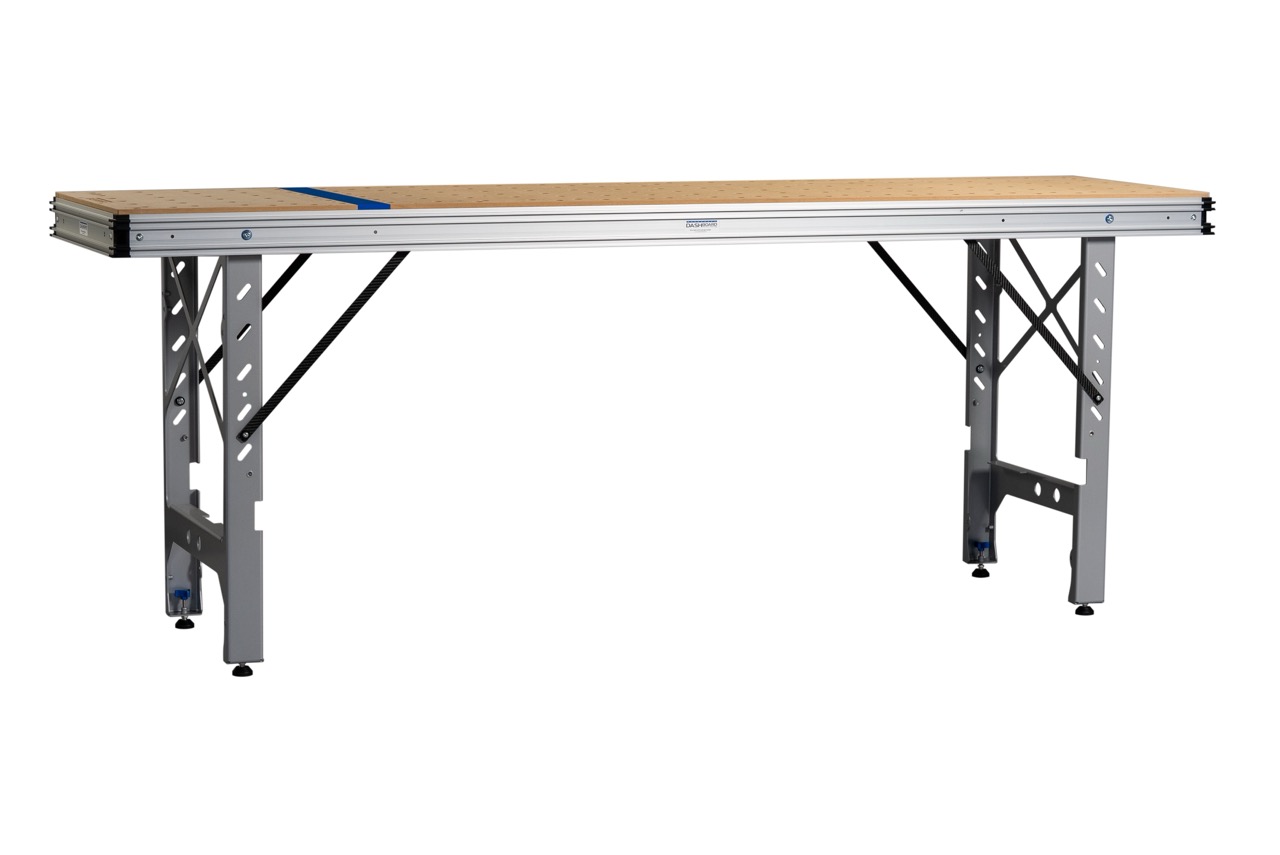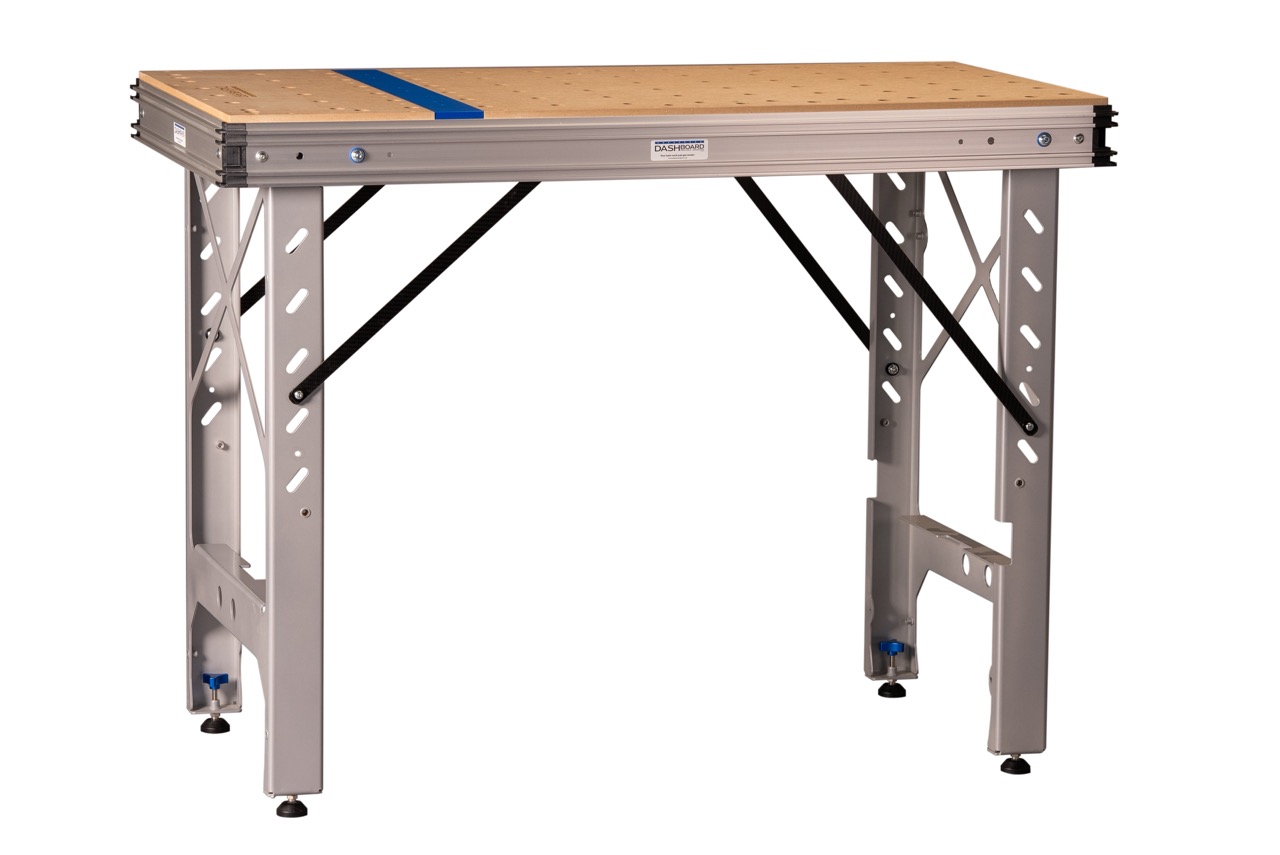TL;DR: Portable Workbenches vs Table Saws for Contractors
Quick Answer: Professional contractors are switching from table saws to portable workbenches because portable workbenches weigh 50% less (60 lbs vs 150 lbs), set up in 2 minutes instead of 30, and provide full sheet cutting capacity without requiring 10 feet of clearance space.
Key Comparison Points:
Weight & Transport:
- Table Saw: 90-150 pounds, may require 2 people
- Portable Workbench: 45-60 pounds, 1-person carry
Setup Time:
- Table Saw: 20-30 minutes (leveling, fence alignment, power)
- Portable Workbench: Under 2 minutes
Space Requirements:
- Table Saw: 8-10 feet clearance needed
- Portable Workbench: Works in confined spaces
Safety Features:
- Table Saw: High kickback risk, 67,000 annual injuries
- Portable Workbench + Track Saw: Zero kickback, enclosed blade
Cutting Capacity:
- Both handle full sheets
- Portable workbench enables 100" rips, 48" crosscuts
Cost Range:
- Table Saw: $300-500 (contractor grade)
- Portable Workbench: $1,000-2,500 (multi-function capability)
Primary Benefits: Reduced transport strain, faster job completion, ability to work in finished homes, elimination of kickback injuries, same precision with better ergonomics.
Best For: Contractors who move between job sites daily, work in residential spaces, value setup speed, and want to reduce injury risk while maintaining professional-grade cuts.
__________________
Professional contractors are ditching table saws for portable workbenches because they're tired of hauling 150-pound saws between job sites, wasting space in cramped work areas, and dealing with back pain from poor ergonomics.
Modern portable workbenches solve these problems while delivering the same precision—and contractors are seeing immediate benefits in their daily work.
The Real Problems with Table Saws on Job Sites
Weight and Transport
- Contractor table saws weigh 90-150 pounds
- Require two people to load/unload safely
- Need dedicated truck space that could hold other tools
- Risk injury every time you move them
Space Requirements
- Table saws need 8-10 feet of clearance front and back
- Most job sites don't have this space
- You end up working in hallways or driveways
- Can't work efficiently in finished homes
Setup Time Kills Productivity
- Level the saw
- Adjust the fence
- Check blade alignment
- Run extension cords
- Total setup: 20-30 minutes
Why Portable Workbenches Work Better

Actual Weight Difference
The Dash-Board Gen 2 workbench weighs just 62 pounds compared to typical contractor saws at 100+ pounds. The ShortCut model weighs only 42 pounds—one person can easily carry it.
Real Working Surface
The Gen 2 extends to 92" x 24"—that's nearly 8 feet of cutting capacity. You can break down full sheets of plywood without wrestling them through a table saw.
Setup in Under 2 Minutes
Dash-Board emphasizes quick setup within minutes. No calibration, no leveling—unfold and start cutting.
Track Saw Compatibility Changes Everything
Precision Without the Fence Dance
Dash-Board's workbenches are specifically designed to optimize track saw performance, with features like 20mm dog hole patterns for precise guide rail setups. Track saws eliminate fence alignment issues—the track IS your fence.
Cut Capacity That Matters
With your track saw, guide rail, and the right configuration of accessories, Dash-Board can enable rips up to 100" (2540mm) and crosscuts over 48" (1219mm). That's full sheet capability without the gymnastics of feeding plywood through a table saw.
Safety Improvements Contractors Actually Notice
No More Kickback
Track saws can't kick back—the blade is enclosed and the material doesn't move. SawStop notes high injury rates associated with traditional table saws, mostly from kickback and blade contact.
Better Working Height
Dash-Board's ergonomic design minimizes wear and tear, fostering a more comfortable and sustainable woodworking experience. Adjustable height means less bending, less lifting, fewer back problems.
What to Look For
Non-Negotiables
- Aluminum construction - Hand-assembled in small production runs, Dash-Board ensures high-quality craftsmanship
- 20mm dog holes - Industry standard for accessories
- Under 70 pounds - One-person carry
- Stable legs - No wobble on uneven surfaces
Worth-Having Features
- 2-piece design with replaceable cut strip
- Rail storage built in
- Height adjustment
- Compatible with accessories like the Guide Rail Bracket Set and The Outrigger
Making the Switch
Most contractors report the same timeline:
- Week 1: Figuring out the new workflow
- Week 2: Starting to appreciate the portability
- Month 1: Wonder why they didn't switch sooner
- Month 2: Old table saw collecting dust in the shop
The portable workbench market is growing, driven by the gig economy and freelance contractors needing flexible workspaces. If you're hauling a table saw to job sites, dealing with space constraints, or tired of the setup hassle, a portable workbench solves real problems that affect your daily work and bottom line.
The switch isn't about having the latest gear, it's about working smarter, finishing jobs faster, and going home without a sore back.
FAQs
Can a portable workbench really replace my table saw for professional work?
Yes, when paired with a track saw. You get the same precision for sheet goods and most cuts contractors need daily. The main limitation is ripping thick hardwood lumber repeatedly—for that specific task, a table saw still wins.
What's the actual time savings on a typical job?
Most contractors save 30-45 minutes per job between faster setup (2 minutes vs 20-30) and not having to reconfigure spaces to fit a table saw. On kitchen installs, that often means finishing a full day earlier.
Do I need to buy a track saw too, or can I use my circular saw?
While you can use a circular saw with edge guides, a track saw is what makes the system shine. The precision and dust collection of a track saw paired with a portable workbench is what delivers table saw-quality cuts.
How stable are these for heavy materials?
Quality aluminum workbenches like Dash-Board's support several hundred pounds without flexing. The key is proper leg adjustment on uneven surfaces. They're actually more stable than many contractor saws because of the wider footprint.
Is this setup actually safer than my SawStop table saw?
Track saws eliminate kickback entirely since the material doesn't move and the blade is fully enclosed. While SawStop prevents blade contact injuries, it doesn't prevent kickback. For overall injury prevention, the track saw/workbench combo has fewer risk points.









.jpeg)
.webp)
